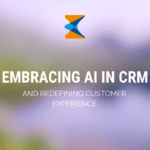
How are CRM Vendors Embracing AI and Redefining the Customer Experience
August 6, 2023
Supercharging Project Management with No-Code
August 6, 2023How to Make your Resume ATS-Friendly
Table of Contents
Understanding ATS
In the realm of human resource management, an Applicant Tracking System, or ATS, has emerged as an invaluable tool. An ATS is essentially a software application that streamlines the recruitment process by automating the initial stages. It enables recruiters and hiring managers to handle job applications and manage resume data electronically.
The operation of an ATS isn't restricted to mere data management. It scans and sorts resumes, looking for matches between the job's required qualifications and the candidate's credentials. Depending on the specific software, it might scan for relevant keywords, employment history, years of experience, educational background, and more. In essence, it efficiently filters the pool of applicants down to the most suitable candidates.
An ATS works by parsing the information in the resumes and saving them in a database. When a job is posted, the software scans the resumes for relevant keywords associated with the qualifications required for the job. The more matches it finds, the higher the ranking the candidate receives. The recruitment team can then review the top-ranking candidates, thus saving a significant amount of time and resources.
Many ATS also offer additional features such as interview scheduling, job posting to multiple platforms, collaborative hiring, and comprehensive reports and analytics. Some systems have even integrated AI technologies to further improve their efficiency and accuracy. For instance, Konfeeg's No Code Web App Builder allows businesses to create their own customized ATS, tailored to their specific hiring process.
Essentially, an ATS helps streamline and optimize the recruitment process, allowing businesses to find the best talent effectively and efficiently. With the rise of remote work and the digital transformation of businesses, the use of ATS is only expected to grow further.
Why is ATS Important?
The rapid advancement in technology and the changing dynamics of the job market have made the Applicant Tracking Systems (ATS) more crucial than ever. The global job market is increasingly competitive, with employers often receiving hundreds, if not thousands, of applications for a single position. Sorting through this overwhelming number of resumes manually is time-consuming and prone to errors, but an ATS can automate this task, thereby saving time and reducing errors.
Firstly, ATSs play a significant role in enhancing the efficiency of the recruitment process. They automatically screen and sort resumes based on preset criteria such as keywords, skills, former employers, years of experience, and schools attended. This functionality allows hiring managers to focus only on the most qualified candidates.
Secondly, ATSs are built to improve the quality of hire. By eliminating the risk of overlooking quality candidates buried under the pile of resumes, they ensure that top-notch candidates are identified and considered. This increases the chance of finding the best fit for the position.
Thirdly, the systems provide a centralized database for candidate information that can be accessed from anywhere, which is particularly important in the era of remote work. This allows for effective communication and collaboration among the hiring team, resulting in a more coordinated recruitment process.
Additionally, an ATS helps to improve compliance with employment laws and regulations. It maintains a record of the hiring process, ensuring that the company has the necessary documentation if their hiring practices are ever audited.
Finally, ATSs contribute to enhancing candidate experience. With an ATS, companies can keep candidates informed about their application status and ensure timely communication. It can also significantly reduce the time to hire, which can improve a company's acceptance rate.
On the path of digital transformation, adopting an ATS is no longer a luxury but a necessity for businesses of all sizes. It significantly simplifies the recruitment process, ensuring that businesses do not miss out on quality candidates due to manual screening processes. Konfeeg, through its no code web app builder, helps businesses build a custom ATS that caters to their unique needs, thereby promoting a seamless hiring process.
Creating an ATS-friendly Resume
With the prevalent use of ATS in the hiring process, job seekers need to ensure that their resumes are ATS-friendly. Here are some practical tips on how to format a resume to be more appealing to an Applicant Tracking System.
1. Simple and Professional Layout
Stick to a straightforward layout with clear headings for each section, such as 'Work Experience', 'Education', and 'Skills'. Avoid using fancy or complex designs, graphics, or logos that could confuse the ATS. Remember, the system favors standard formatting over creative designs. Also, refrain from using tables or columns as ATSs may not read them correctly. Stick to the standard resume format with text flowing from left to right.
2. Use a Standard Font
Use standard fonts such as Arial, Calibri, Georgia, or Times New Roman, which are easily readable by most ATSs. Avoid using fonts that are artistic or hard to read as they may not be recognized by the ATS, causing parsing errors.
3. Choose the Right File Type
When saving your resume, choose a file type that is universally accepted by ATSs. Plain text (.txt), Microsoft Word (.doc or .docx), or PDF (if the ATS specifically mentions that it can read PDF files) are generally the safest choices. Avoid file types like .jpg or .png that are not text-based.
4. Incorporate Relevant Keywords
Include the relevant keywords and phrases that reflect your skills and experiences. These keywords should align with the ones used in the job description. The ATS will scan for these keywords to determine if your resume matches the job requirements. However, avoid keyword stuffing as some sophisticated ATSs can recognize this and may even penalize your application.
5. Correct Placement of Contact Information
Do not place contact information in the header or footer of the document, as some ATSs may not scan these areas. Place your contact information at the top of the first page of the resume, but under your name and title.
6. Use Standard Acronyms and Titles
Use both full words and their acronyms to ensure the ATS recognizes your skills and qualifications. For example, 'Bachelor of Arts (BA)'. Similarly, use standard job titles ('Sales Manager' instead of 'Sales Guru') so the ATS can match your experience with open positions.
These are just a few of the many strategies to make your resume ATS-friendly. Remember, while the modernization of applications like ATS has made hiring more efficient, the human element is still crucial. Once your resume passes through the ATS, a human will read it, so ensure it not only matches the job requirements but also showcases your value as a potential employee.
Keyword Optimization in a Resume for ATS
In today's digital job market, optimizing your resume with the right keywords is crucial. Applicant Tracking Systems (ATS) often act as the first gatekeeper, scanning and ranking resumes based on their relevance to the job description. Therefore, understanding how to use keywords effectively can make the difference between your resume being seen by a hiring manager or disappearing into the digital void.
Why is Keyword Optimization Essential?
Keyword optimization is essential because ATS algorithms are designed to identify and rank resumes based on how well they match the job description. If your resume contains the relevant keywords used in the job posting, the ATS will score it higher, and it's more likely to end up in the hands of a human recruiter.
In essence, keyword optimization not only increases your chances of passing the ATS screening but also demonstrates to the hiring manager that your skills and experiences align with what the company is looking for. This could increase your chances of getting an interview invitation.
How to Optimize Keywords in a Resume for ATS
- Identify Keywords in the Job Description: The first step in keyword optimization is to carefully read the job description and identify the primary keywords. These are often the specific skills, qualifications, and experiences required for the job.
- Use Keywords Naturally: Once you've identified the keywords, incorporate them into your resume naturally. For instance, if the job description requires 'project management' skills, you can include a line in your resume such as 'Led a team in a project management role, overseeing the successful completion of multiple projects.' Avoid 'keyword stuffing' or unnaturally shoehorning keywords, as it can make your resume unreadable.
Remember, making your resume ATS-friendly is just the first step in your job search journey. Once you pass this stage, your resume will be reviewed by a human who will appreciate a well-structured and clearly written resume. Keep in mind that while an ATS-friendly resume can get you through the door, your skills, experiences, and interview skills will land you the job.
At Konfeeg, we understand the intricacies of these systems and how they are evolving with the rise of no-code and low-code technologies. We offer a no-code platform that can help businesses build their own customized ATS to streamline the hiring process.
ATS and Cover Letters: An Overview
While an Applicant Tracking System's primary role is to scan resumes, many ATS solutions are also designed to scan cover letters. A well-optimized cover letter can provide another layer of keywords and context that can further boost your chances of passing the ATS scan.
Does ATS Scan Cover Letters?
Yes, many ATSs do scan cover letters, and some employers even configure their systems to give preference to applicants who include one. This means that if you provide a cover letter, you could potentially increase your chances of making it through the initial ATS screening. However, like your resume, your cover letter needs to be optimized for the ATS to be effective.
How to Optimize Cover Letters for ATS?
Just as with your resume, optimizing your cover letter for an ATS involves including relevant keywords from the job description. Here are some tips to help you craft an ATS-friendly cover letter:
- Include Keywords from Job Description: Just as you would in your resume, use keywords in your cover letter that match those in the job description. Be sure to use them naturally and in context. vbnet Copy code
- Stay Relevant: Your cover letter is a chance to share your story and connect your experiences to the job role. Be sure to focus on your most relevant skills and experiences. This not only makes it easier for the ATS to score your application but also helps the hiring manager see how you would fit into the role.
- Use Standard Section Headers: Some ATSs may have trouble understanding unconventional headings, so stick with standard ones such as "Work Experience" or "Education".
- Use a Simple Format: Like your resume, your cover letter should be formatted simply to be easily scanned by an ATS. Avoid graphics, text boxes, or unusual fonts.
Remember that while ATS software is a powerful tool, it's ultimately a human who makes the final decision. So, while it's important to optimize your cover letter for an ATS, it's equally important to write it in a way that resonates with the person reading it.
At Konfeeg, we know how crucial it is for companies to streamline their hiring process. That's why our no-code platform allows businesses to create their own ATS tailored to their specific needs. This not only enhances the efficiency of their recruitment but also improves the overall digital transformation journey.
Common Mistakes in Optimizing Resumes for ATS and How to Avoid Them
Creating an ATS-friendly resume is not just about including the right keywords and following a standard format. There are several pitfalls that job seekers should avoid to ensure their resume doesn't get discarded by an ATS before it even reaches a human reviewer. Let's explore some of these common mistakes and how to avoid them:
-
Keyword Stuffing
Keyword stuffing, or overusing specific words and phrases in a bid to trick the ATS, is a common mistake. This not only makes your resume read unnaturally, but modern ATS algorithms can also detect this and may even penalize your application. How to avoid: Use keywords naturally within the content of your resume and always in the right context. It's more about relevancy than frequency.
-
Using Complex Formats
Some job seekers use complex formats, including images, charts, and unusual fonts, to make their resume stand out. Unfortunately, most ATSs struggle to read such elements, leading to crucial information being missed. How to avoid: Keep your resume format simple and clean. Stick with standard fonts, and avoid using images or graphics.
-
Choosing the Wrong File Type
Submitting your resume in a file type that the ATS cannot process can result in your application being rejected. How to avoid: Submit your resume in a commonly accepted format such as .docx or .pdf, unless the job posting specifies otherwise.
-
Not Tailoring the Resume to the Job Description
Each job is unique, and so should be your application. A one-size-fits-all approach won't help your resume pass the ATS. How to avoid: Tailor your resume to each specific job by using the keywords and phrases from the job description and focusing on the most relevant skills and experiences.
By avoiding these common mistakes, you can improve the chances of your resume making it past the ATS and onto the desk of a hiring manager. At Konfeeg, our application modernization approach helps businesses adopt the latest ATS technologies, making the hiring process smoother and more efficient. Learn more about our approach and how we're unleashing potential by building success with no-code platforms.
Popular ATS Tools for Job Seekers: Features and Benefits
While ATS systems are primarily designed for employers, there are tools that can help job seekers optimize their resumes to get past these systems. Here are some of the most popular ones:
-
Jobscan
Jobscan is a tool that allows you to compare your resume against job descriptions. It scores your resume based on how well it matches the job description, and provides tips on how to improve it. Jobscan can identify and measure the frequency of relevant keywords, detect formatting issues that might cause an ATS to reject the resume, and give insights on how to tailor the resume for a specific job role. The tool is easy to use and can greatly increase your chances of getting an interview.
-
Rezunate
Rezunate is an intelligent web-based tool that helps job seekers optimize their resume for specific job postings. It uses ATS-like algorithms to score the resume against job descriptions, and provides detailed feedback and recommendations for improvements. With Rezunate, you can be sure that your resume not only passes the ATS but also appeals to hiring managers.
-
Skillroads
Skillroads is an AI-powered career development platform that provides ATS-friendly resume writing and editing services. The platform uses intelligent algorithms to match your skills and experiences to job descriptions, ensuring your resume is highly relevant and ATS-optimized. It also offers a comprehensive career development service, including professional resume writing, LinkedIn profile optimization, and interview coaching.
These tools can play a vital role in helping job seekers navigate the ATS process and increase their chances of landing an interview. Remember, the aim is not to trick the ATS, but to ensure your resume effectively communicates your skills and experiences that are relevant to the job.
At Konfeeg, we empower businesses with no-code web app builders to streamline their HR processes, including ATS. Our platform promotes digital transformation and helps businesses to stay competitive in today's evolving job market. For more insights, check out our use cases and explore how we're unlocking innovation with our no-code platforms.
Introducing Konfeeg's No-Code ATS Solution: Features and Benefits
At Konfeeg, we are keenly aware of the challenges both businesses and job seekers face in the modern job market. To this end, we have developed a revolutionary no-code ATS solution that is transforming the recruitment landscape.
Our ATS system is designed with simplicity, efficiency, and effectiveness in mind, enabling businesses to hire the right talent swiftly and job seekers to optimize their resumes successfully.
Features of Konfeeg's No-Code ATS Solution
- Easy to Use: Our ATS system requires no coding skills, making it accessible to businesses of all sizes. The user-friendly interface allows hiring teams to navigate the platform seamlessly, managing all aspects of the recruitment process in one place.
- Resume Parsing: Our ATS system leverages advanced AI technology to parse resumes automatically. It sifts through thousands of resumes, extracting pertinent information such as qualifications, skills, and experiences.
- Job Posting: With Konfeeg's ATS, businesses can post job vacancies to multiple job boards with a single click. This feature saves time and increases the visibility of job postings.
- Candidate Ranking: The platform ranks candidates based on how well their resumes match the job description. This feature allows hiring teams to focus on the most qualified candidates, optimizing the hiring process.
Benefits of Konfeeg's No-Code ATS Solution
- Streamlined Hiring Process: Our ATS system simplifies the hiring process, enabling businesses to fill positions faster and more efficiently.
- Improved Candidate Experience: By automating the initial screening process, our ATS ensures all applicants receive timely responses. This feature enhances the candidate's experience, improving the company's employer brand.
- Cost-Effective: Konfeeg's no-code ATS solution saves businesses significant costs associated with lengthy hiring processes. By optimizing the recruitment process, businesses can minimize the cost-per-hire.
- Reduced Bias: By focusing on the qualifications, skills, and experiences relevant to the job, our ATS helps reduce unconscious bias in the hiring process.
To find out more about our no-code ATS solution, consider getting early access or exploring more use-cases on our platform.
Summary: Making Your Resume ATS-Friendly
In this comprehensive guide, we delved into the topic of Applicant Tracking Systems (ATS), their purpose, and how they function in the modern job market. ATS software is used by most companies today to filter and manage high volumes of job applications, helping recruiters to identify the most qualified candidates for a given position.
The role of ATS in today's job market is vital. For employers, an ATS provides a streamlined, automated, and efficient way to handle the recruitment process. It not only saves time and resources but also helps to eliminate human bias and improve compliance.
We offered various tips to optimize your resume for ATS, focusing on the importance of layout, font, file type, and especially the correct use of keywords. Keyword optimization is essential as ATS algorithms match the keywords in your resume to those in the job description.
Similarly, we discussed how ATS scans cover letters. While not all ATS systems are designed to scan cover letters, it's prudent to optimize them similarly to your resume, using relevant keywords and a format that's easy to parse.
We covered some common pitfalls job seekers encounter when optimizing their resumes for ATS and how to avoid them. Among these are using a complex layout or design, including important information in headers or footers, and overstuffing the resume with keywords.
The guide introduced popular ATS tools available for job seekers, highlighting their unique features and benefits. These tools can provide a valuable edge in the competitive job market.
Finally, we introduced the No-Code ATS solution provided by Konfeeg. Our platform is designed with simplicity, efficiency, and effectiveness in mind, and includes features like easy usability, resume parsing, job posting, and candidate ranking. The benefits of using our solution include a streamlined hiring process, improved candidate experience, cost-effectiveness, and reduced bias in hiring.
In conclusion, understanding how ATS works and how to optimize your resume for these systems is vital in today's digital job market. With the right approach and tools, you can increase your chances of landing that dream job.





